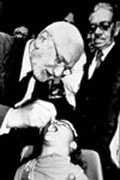
Worksheets and No Prep Teaching Resources
Reading Comprehension Worksheets
The 1950's

The 1950's
 Worksheets and No Prep Teaching Resources Reading Comprehension Worksheets The 1950's |
 The 1950's |
| edHelper's suggested reading level: | grades 7 to 9 | |
| Flesch-Kincaid grade level: | 7.56 |
|
War on Disease, Part 2 - New Weapons
By Toni Lee Robinson |

|
 1 Some children given the Salk vaccine had come down with polio. The vaccine used for the injections had been produced in several batches by different companies. A study revealed that the suspect injections had come from one batch. The company that had produced the bad batch hadn't been careful in its methods. The polio virus hadn't been fully killed before it was used. The children injected with that batch of vaccine had received live polio virus.
1 Some children given the Salk vaccine had come down with polio. The vaccine used for the injections had been produced in several batches by different companies. A study revealed that the suspect injections had come from one batch. The company that had produced the bad batch hadn't been careful in its methods. The polio virus hadn't been fully killed before it was used. The children injected with that batch of vaccine had received live polio virus. |
Create Weekly Reading Books
Prepare for an entire week at once! |
| Leave your feedback on War on Disease, Part 2 - New Weapons (use this link if you found an error in the story) |
 |
The 1950's
|
 |
High School Reading Comprehensions and High School Reading Lessons
|
 |
United States
|
|
|
 | Fifty States Theme Unit |
 |
Document Based Activities |